
Featured Harp Guitar of the Month
Gibson Harp Guitars: To the World’s Fair and Beyond!
by Gregg Miner, June, 2016
(Updated November, 2018)
|
|
Chapters: ·
Dreams and Time
Machines ·
Gibson’s 1904
World’s Fair Exhibit ·
The World’s Fair
Presentation Harp Guitar ·
Orville Gibson’s
Role ·
Back to the Fair ·
The “c.1906
Presentation Harp Guitar” · Other Gibson Presentation Grade Harp Guitars |
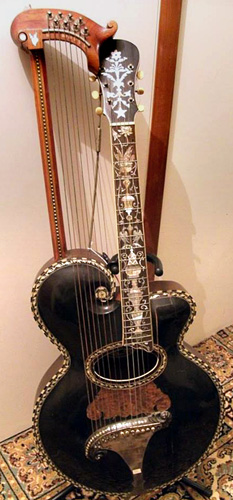 |
|
Dreams
and Time Machines Ever since I became interested in vintage and unusual stringed instruments (this was back in high school) and started learning about their history and musical and cultural settings, I’ve A) yearned for a Time Machine and B) in lieu of that, had this sporadic but insistent recurring dream: I’m back at the turn of the previous century strolling through one of the exhibitions I am always reading about – you know, the state or world fairs where exhibitors would book space in these immense fanciful buildings and set up these enormous, gorgeous wood frame displays cases full of their inventions and wares. Imagine not only strolling through and soaking up that vibe, but at the same time viewing brand new musical instruments by Lyon & Healy, Joseph Bohmann or the Gibson Company. Surely I’m not the only one who fantasizes about such scenes? Below
is one tantalizing glimpse – the dream made photo-real.
|
||
|
Gibson’s 1904 World’s Fair Exhibit It was thus in sharing my harp guitar knowledge with her that the World’s Fair topic came up. Here then, is Gibson’s exhibit at the 1904 Louisiana Purchase Exposition, better known as the St. Louis World’s Fair: Yowza! As it was rather a dark building I took the liberty of dramatically lightening the original image in order to see better detail on the instruments. Their neighbor’s violin family case unfortunately blocks a bit of our view, but pays for it by having their own backdrop of “Sauer’s Vanilla.” Brand new Gibson mandolins, guitars and harp guitars...I’ll let you decide precisely when these beautiful instruments might have been constructed...and by whom. But a few things you should know: * The Gibson Company was formed on October 10th, 1902. But the first catalog didn’t mail out until “about the first of February,” 1903 (I proudly take credit for that little discovery). We believe it depicts exclusively Orville-built instruments. * Peggy revealed in her blog the very limited production capabilities of the new company, announced in this December 7th (Sunday), 1902 clipping:
* Peggy also shared an Indianapolis “want ad” posted a full year into production (December 11th, 1903) looking specifically for four “benchmen for celluloid and pearl work.”
* Julius Bellson stated in his 1973 The Gibson Story that Orville originally had a two-year contract, but “further employment was later agreed to.” Peggy notes that his title was “Superintendent,” but we both conjecture that he was by necessity an extremely hands-on boss. * The World’s Fair was originally scheduled for 1903 – to coincide with the 100-year anniversary of the Louisiana Purchase. But it was postponed and didn’t open until April 30, 1904. Even then (as Peggy found), Gibson’s exhibit in the Liberal Arts building didn’t open until about mid-June, a month and a half into it. We think that Gibson took advantage of the delay and decided to “go for it” – and so they did. |
|
|
The World’s Fair Presentation Harp Guitar |
|
|
As soon as I saw the St Louis Fair photo, I went back to look at the “1904 World’s Fair” harp guitar in the Gruhn/Carter and Walter Carter books Acoustic Guitars and The Gibson Story. Great news – it looks like a match! It was presented in the two books above as the “1904 World’s Fair harp guitar,” and there doesn’t seem to be any reason to doubt it. If there was any smoking gun provenance when it was discovered, or even a story, that has been lost to time. Happily, Joe was able to provide the serial number – #2783. According to my (as yet unpublished) spreadsheet, this perfectly coincides with the early 1904 timeline (few, if any, of these early Gibson instruments had FON numbers). Overlooked at the time the photos were taken was the all-important scale length. With the slightest Photoshop perspective tweaking and overlaying it on my long-scale Gibson image, I was able to deduce that 2783 likely also has the 27-1/4” scale, as I theorized. Orville
Gibson’s Role Back to the question of who built this special presentation harp guitar. Peggy and I seem to have independently reached the same opinion – that at minimum, Orville supervised its construction, and at the opposite end of possibilities, he built it 100% on his own. The most likely is somewhere in-between – for example, Orville may have had some quality woodworking and finish help by then, and some of the four new pearl workers mentioned above (assuming they had been found and hired) could have presumably become skilled enough to have done the demanding inlay work. By the way, does anyone have information on this fretboard pattern, or can anyone suggest a name? (So I can stop calling it the “stack of urns and flowerpots”) Some time ago my Gibson research pal Benoit Meulle-Stef (Ben) and I learned to look for identifying visual “Orville features” on early harp guitars and images. One is the “body lump” at the right side of the neck, an indication that it utilizes Orville’s original patent-style construction. On all later harp guitars the body’s upper bout goes (visually) straight across to the other side, due to the standard neck heel attachment. The telltale bulge is a result of the entire rim, back and neck being carved from one giant chunk of wood (on the huge harp guitars, first laminated/joined from three separate pieces: rim, back and neck).
|
|
| If difficult to see from the front, the proof of this construction would be seen on the back (thank you Walter for shooting that angle!) – and sure enough, when the Gruhn staff dug out the photos of 2783, the back shows the solid back & sides patent construction with its distinctive large flat middle and “double curve” carving way out at the edge. | ||
| As
the original Orville harp guitars – including the 1903
catalog Style U and specimen
#2502 – had that huge oval soundhole, the
smaller soundhole was once assumed to imply
”post-Orville.”
Clearly, this was not the case; Orville must have
made the change himself, perhaps realizing (or
experiencing) a design defect in that giant gaping hole.
Similarly, Orville must have also seen the advantage of geared neck tuners over his original friction tuners, and would soon adopt that change himself. In fact, an earlier Orville-construction Style R, serial #2770 has geared tuners (originality not confirmed, but looks correct). Another theoretical “Orville-built” harp guitar feature is the “notched bridge.” Ben noticed this unusual carved motif immediately when #2502 was discovered in 2007. A couple of other very early harp guitars have it, including the World’s Fair HG. It’s interesting to note that the World’s Fair harp guitar has no metal support strap for the bridge, which nearly all other early models have. Perhaps this was thought to be more attractive for presentation? After all, it was originally intended as a display instrument rather than a professional players’ instrument. Note the nine sub-basses on #2783. Though never seen or referred to in literature, this has been found by Ben and myself to have been the most common – and possibly “standard” – configuration for the large, long-scale Style U’s in the early years of c.1904-1906. Its specific tuning remains unknown but may have been D# chromatically down G, as suspected by Ben (the same as the German 9-bass chromatic kontragitarre tuning). |
||
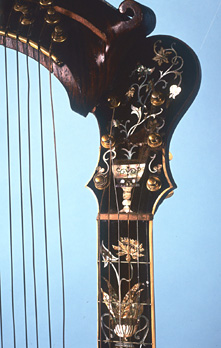 |
||
|
Note that the plain Style U harp guitar on the back wall has nine subs also. |
||
|
Peggy
pointed out the three framed pre-June, 1904 photos on
the wall, including a classic image hiding behind the
palm tree she recognized as the “Mexican Musical
Monarchs.” My original
copy of this wonderful and extremely
important photograph came from researcher Michael
Wright, with no identifying information.
Peggy
had found it in Bellson’s book, where their
testimonial is included, dated “April 10, 1903,
Spokane, Wash” (at left, with text highlighted).
Even better, Peggy found several newspaper
accounts of the Monarchs ordering or receiving their new
Gibsons! These
poorly written accounts (one even states that they were
a “cello-harp”
and “manduria”
custom made in Madrid!) are not very clear.
Peggy interprets the various clues as suggesting
that the duo ordered the instruments directly from
Orville in the early fall of 1902, which he then
completed in February.
I favor a scenario where the duo ordered them in
February, 1903 – perhaps after obtaining the brand new
catalog – and may
have received the very instruments already pictured in
the first catalog. Or
perhaps both are correct: the instruments were commissioned, Orville built
them, the new Company included them in the first catalog
– with their new “official” model numbers – and then they were
shipped off. Finally,
there is still the less likely possibility that Orville
(and possible new workers) built them brand new
instruments within two months. Regardless of the specifics, we know that the constantly-touring team received the instruments in Seattle upon returning to the mainland after several weeks in Alaska. Shortly (or immediately) after, on April 10th, they wrote their testimonial letter to the Gibson Co. (not to Orville, though that could have been expunged). One discrepancy is the little decorative point on the sub-bass head that seems to be missing in the photo – it’s difficult to say if that tiny dark spot is it. It also may have been broken off, considering that very few seem to have been built without this distinctive design element. Besides the large soundhole, the singular defining characteristic of the Monarchs’ Style U and the first Gibson Company catalog Orville-built Style U harp guitar (also appearing in the April, 1903 Cadenza ad at right) is the scroll carved in relief in the headstock. No other specimen (or image) has been seen with this feature. |
||
|
Here is a slightly better resolution of the photo from a Crescendo issue five years later (May, 1909. Clearly the Gibson Company kept these photos in their files for years and would trot them out indiscriminately for their assorted Cadenza and Crescendo ads and in-house catalogs. A perfect illustration of how when we use such “publication dated” photos for provenance, we only know they were photographed by that date, not necessarily in that period...this example appeared at least five years after the fact.) Of equal
interest to me is the photo Gibson included in their
exhibit that inexplicably features a Dyer
harp guitar! Alas,
the resolution is too poor for us to make out, but it
does not match
any Dyer image I’ve yet seen.
That’s too bad, because while the image dates
from pre-June, 1904, it looks like a possible Type 2 Dyer (the common version), which as far
as we have been able to establish, wasn’t introduced
until December, 1904! By the way, in
October, 1904 the Gibson Mandolin-Guitar Company was
given the “highest award at the World’s Fair. Their
exhibit is the most interesting and attractive of any at
the Exposition.” I,
for one, am not surprised! |
||
|
The
1906 Presentation Harp Guitar This whole new (re) investigation of mine into the fascinating 1904 era harp guitars was actually prompted by this next instrument – and it is a stunner. |
|
|
If your eyeballs are going “boing!” like the wolf in a Tex Avery cartoon, you needn’t apologize. In private hands, this fantastic Gibson harp guitar was purchased by a late collector around 1950, when they were told it was a “backup for the World’s Fair harp guitar, in case anything happened to that one...” – or words to that effect. Judging by its bling, there could certainly be some truth to the story! However, there are some significant differences in features which point to a later date – well after the fair’s closing – though perhaps it was thought that the Company needed a second presentation-grade harp guitar in inventory/storage for future occasions. There was certainly nothing coming up soon – though Peggy mentioned two local Kalamazoo department store displays where it would have been welcome (if perhaps overkill). Another option is that it was a custom order by some unidentified wealthy performer. We’ll probably never know. Confirming the later date, after suggesting the “black light trick” (in a darkened room, it will illuminate faded pencil inscriptions), the owners were able to read and photograph the faded label – serial #5703. What luck! This puts it reliably in early 1906 per our current timeline (so much so that I’ve eschewed the “circa” qualifier). As we happen to have a “smoking gun” date of March 17, 1906 for harp guitar #5760, my extrapolation of production puts 5703 also in early March, 1906 (taking into account a significant production ramp up) or late February (using an unlikely consistent monthly/yearly output) . The features nicely match up with this time period, though there are of course many custom elements. It does have some common features with the 1904 World’s Fair harp guitar, and it similarly begs the question: how much was Orville’s design and/or work? The first difference is that it is not the large-bodied, long-scale Style U – per the owners, it is 18” wide with a 25-1/2” scale. Thus it’s the smaller Style R – as the proportions of the scroll within the body shape confirm. (See my blog Huge, Huger, Hugest for comparing the four basic Gibson harp guitar model configurations of size, shape and scale.) |
|
| By 1906 – and probably a good year or two earlier (i.e.: quickly) – the company had done away with Orville’s original patented construction with the solid single rim and gone to normal bent sides. At the same time, the neck block and heel transformed into a more normal dovetail, with the carved back taking on the more “modern” contours of the top (though both would remain abnormally thick). I don’t think this precludes Orville’s involvement; he was almost certainly still supervising, and possibly even building during this period. But we can only guess as to his frame of mind and opinions about the new direction “his” instruments were taking. |
As mentioned earlier, I can easily imagine Orville being receptive to the more accurate and reliable geared tuners, which appeared after 1904. |
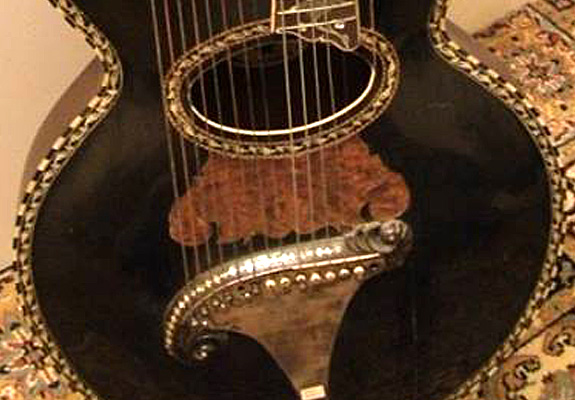
One obvious Orville holdover – or perhaps a reappearance – is the symmetrical inlaid pickguard under the soundhole (assuming it’s original). It’s a lovely touch. |
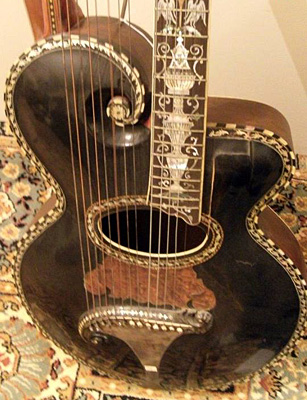
Overall, this instrument is fancier than the World’s Fair example by a significant amount. It has a double row of ornate top binding. Bling-o-rama! |
|
This additional pattern is repeated for the soundhole, making it stand out much more than the others’ shell would have. Note also the design of the fingerboard termination, different than that of the Fair’s. |
The flower in the scroll is a wonderful touch! |
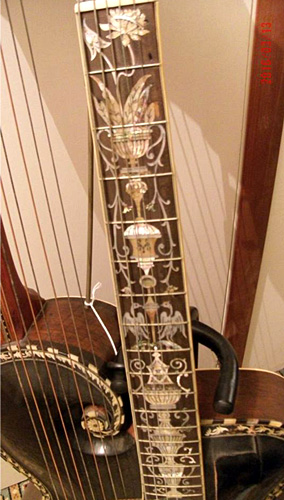 |
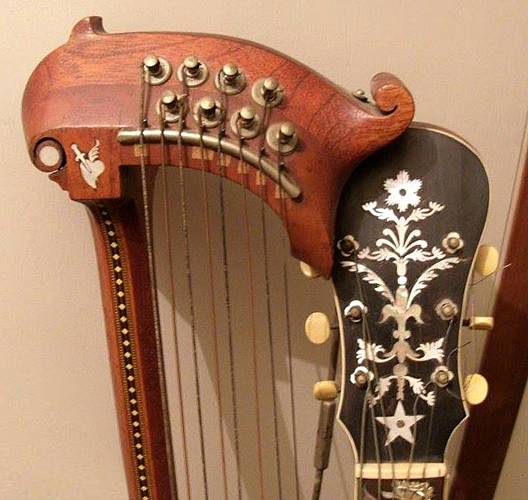 |
|
While the fretboard inlay is the same pattern as all those on this page, the headplate inlay is curiously non-matching. An original design choice? – or an indication of later alteration? Both fretboard and headstock are bound (assumed ivoroid), as are most of the instruments in this article. I love the “zipper” on the harp arm of both of these presentation instruments – a delicate black and white inlay. It also appears on the c.1904 Tetrauq instrument above and the two “stair-step bridge” specimens below. Note
the unique dagger-through-the-winged-heart inlay on the
sub-bass headstock.
Surely this has some significance – can any
reader solve the mystery? |
|
|
Even the carved scroll bridge has a series of diamond-shaped inlays. The carving looks more ornate also, and appears to have the bottom edge “Orville notches.” The metal strap tailpiece is the one incongruity – surely a later addition. |
Gibson packed the maximum amount of sub-bass strings on this R model: eight, whereas the larger Style U had a minimum of nine. |
|
This seems to be the dividing line – no R has been seen with more than eight and no early U has been seen with less than nine. The common post-1908 U of course had ten as standard, with at least one custom 6-bass known (Frank Vardon’s). For the original R – discontinued before 1908 – six was standard (with standard sub-bass tuning), but special orders with seven and eight subs have been seen. Seeing eight on this presentation model makes me envision a specific customer request rather than a Gibson experiment. This stunning instrument with just a few areas of damage is expected to be handed down to the next generation as an investment. Here’s to hoping it winds up properly preserved in one of our better museums someday. Update, November, 2018: I discovered that I had historical photos of this very instrument in my files! See Gibson Harp Guitar No. 5703 Lost and Found.
|
|
|
Other
Gibson Presentation Grade Harp Guitars I know of three other 1900’s Gibson harp guitars with the same presentation fretboard and headstock as the 1904 World’s Fair instrument. What’s fascinating is that each of these has the unusual “stair step” bridge. One survives, and two historical images reveal the others (with at least the possibility that it is a single instrument that changed hands). |
|
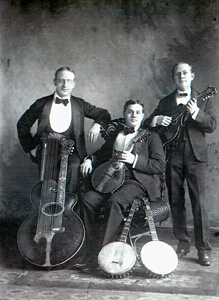 |
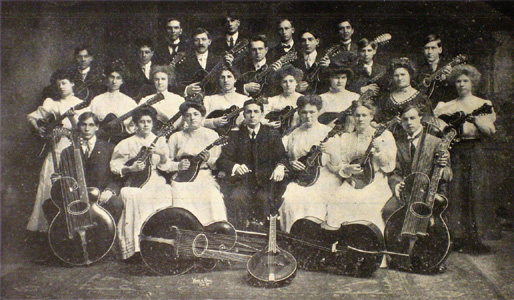 |
|
At left is The Genesee Trio, circa 1906. Left to right is Nathaniel R. Boswell, Edwin D. Wilber and unknown. Nat originally played violincello with the trio circa 1900-1902. There are no records of them in the exact timeframe of their Gibson harp guitar, discussed next. The rare images come from Mark Wilber (Edwin’s grandson). Interestingly, a decade later in 1916 Nat and Edwin would invent and patent the 17-string Tonaharp – a clever acoustic Hawaiian guitar with three separate distinct tunings spread across its strings (major, diminished and minor tuning). The impressive Boston Academy of Music Mandolin Orchestra of Cincinnati, Ohio appeared in the November, 1908 Cresendo. Three pre-1908 scroll bridge U harp guitars in this photo make a bold statement, don’t they? The two on the left are the more common standard scale, 10-bass versions, the one on the right seems to be an exact duplicate of the Genesee instrument. This is assuming the scales are the same, which I think they are (again, factoring in the perspective problem). |
|
|
Update, 2018: The surviving instrument – from the late Scott Chinery collection (now in another private collection) appears identical in all ways to the above specimens, except that it has ten original sub-bass strings. We know that Gibson standardized this string count and new tuning for their redesigned 1908 Style U, and that it was Walter Boehm who came up with the tuning in 1906 (per Gibson's Harp Guitar Brochure). The 10-bass tuning was thus already common on the standard scale scroll bridge U’s of circa 1907-1908. I was able to examine this instrument in late 2018, and verify its scale (25-13/16") and serial number (8544, which puts it in 1908 per my system, not the 1906 reported by the Chinery book authors, nor 1909 as per Spann's Guide). Not counting Orville’s surviving table-standing, pre-Gibson harp guitar (discussed here), at least one other later (‘teens) U has been seen with a fancy pearl fretboard, but it is a non-original replacement, done just for fun. Fun, indeed. See you at the Fair! |
|
Harp Guitar of the Month: Archives |
| Collectors,
Authors, Scholars: Want to create a page about a certain harp guitar
maker or instrument? Contact
me!
|
|
If you enjoyed this article, or found it
useful for research, please consider making a donation to The
Harp Guitar Foundation, |
|
|
|
All Site Contents Copyright © Gregg Miner,2004-2020. All Rights Reserved. Copyright and Fair Use of material and use of images: See Copyright and Fair Use policy. |